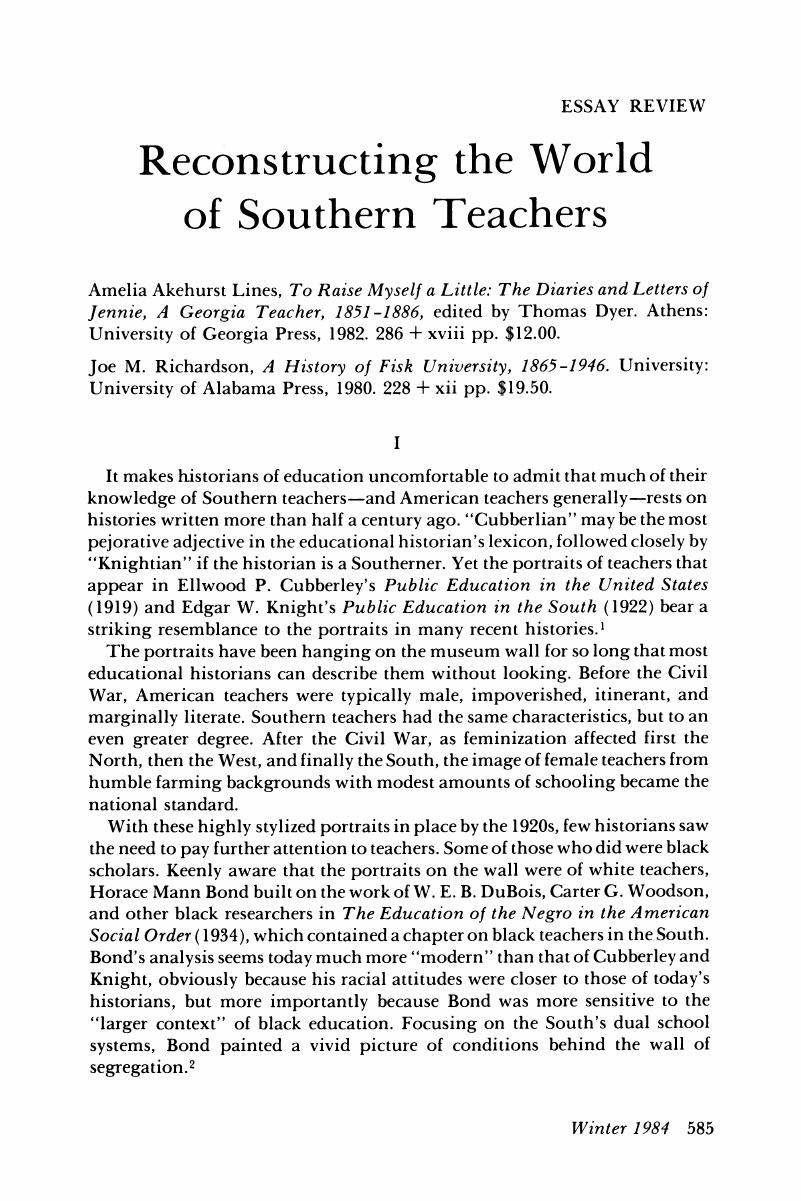No CrossRef data available.
Article contents
Reconstructing the World of Southern Teachers
Published online by Cambridge University Press: 24 February 2017
Abstract

- Type
- Essay Reviews
- Information
- Copyright
- Copyright © 1984 by History of Education Society
References
Notes
1. Cubberley, Ellwood P., Public Education in the United States: A Study and Interpretation of American Educational History (Cambridge, Massachusetts, 1919); Knight, Edgar W., Public Education in the South (Boston, 1922). Just as Cremin, Lawrence A. criticized Cubberlian history in The Wonderful World of Ellwood Patterson Cubberley (New York, 1965), Southern historian Allison, Clinton B. has recently taken Knight to task in “The Appalling World of Edgar Wallace Knight,” Journal of Thought 18 (Fall 1983): 7–14.Google Scholar
2. Bond, Horace Mann, The Education of the Negro in the American Social Order (New York, 1934). Among the studies Bond drew on were DeBois, W. E. B., ed., The Negro Common School, Atlanta University Publications, No. 6 (Atlanta, 1901); DuBois, and Dill, Augustus G., eds., The Common School and the Negro American, Atlanta University Publications, No. 16 (Atlanta, 1911); DuBois, , The Souls of Black Folk (New York, 1903); and Woodson, Carter G., The Education of the Negro Prior to 1861 (New York, 1915) and The Mis-Education of the Negro (Washington, 1933). Bond's chapter on teachers relied heavily on McCuistion, Fred, The South's Negro Teaching Force (Chicago, 1932).Google Scholar
3. Elsbree, Willard S., The American Teacher: Evolution of a Profession in a Democracy (New York, 1939). The quotation is from p. v. Google Scholar
4. Swint, Henry L., The Northern Teacher in the South, 1862–1870 (Nashville, 1941); Wesley, Edgar B., NEA: The First Hundred Years (New York, 1957). Historians did turn their attention to teacher organizations during the 1960s and 1970s. See, for example, Zitron, Celia L., The New York City Teachers Union, 1916–1964: A Story of Educational and Social Commitment (New York, 1968); Taft, Philip, United They Teach: The Story of the United Federation of Teachers (Los Angeles, 1974); Eaton, William E., The American Federation of Teachers, 1916–1961: A History of the Movement (Carbondale, Illinois, 1975); and Urban, Wayne J., “Organized Teachers and Educational Reform during the Progressive Era: 1890–1920,” History of Education Quarterly 16 (Spring 1976): 35–52. Tyack, David B. broke with the “standard portrait” tradition in The One Best System: A History of American Urban Education (Cambridge, Massachusetts, 1974).Google Scholar
5. The new studies include Butchart, Ronald E., Northern Schools, Southern Blacks, and Reconstruction: Freedmen's Education, 1862–1875 (Westport, Connecticut, 1980); Hoffman, Nancy, Woman's “True” Profession: Voices from the History of Teaching (Old Westbury, New York, 1981); Jacoway, Elizabeth, Yankee Missionaries in the South: The Penn School Experiment (Baton Rouge, Louisiana, 1980); Jones, Jacqueline, Soldiers of Light and Love: Northern Teachers and Georgia Blacks, 1865–1873 (Chapel Hill, North Carolina, 1980); Morris, Robert C., Reading, 'Riting, and Reconstruction: The Education of Freedmen in the South, 1861–1870 (Chicago, 1981); and Urban, Wayne J., Why Teachers Organized (Detroit, 1982). If four of the above titles are any indication, the Yankee schoolmarm is alive and well in the history of Southern education.Google Scholar
6. Editor Dyer analyzes these and other aspects of Jennie's outlook in his excellent introduction, pp. 1–11.Google Scholar
7. Strickland, Charles, “Putting in the People: Uses of Biography in Educational History,” invited address to the History of Education Society, 14 October 1977; Clifford, Geraldine J., “Home and School in 19th Century America: Some Personal-History Reports from the United States,” History of Education Quarterly 18 (Spring 1978): 3–34. Finkelstein, Barbara J. has provided a guide to some first-person “recollections of teaching” in “Schooling and Schoolteachers: Selected Bibliography of Autobiographies in the Nineteenth Century,” History of Education Quarterly 14 (Summer 1974): 293–300.CrossRefGoogle Scholar
8. Welter, Barbara discusses nineteenth-century ideas of “a woman's place” in “The Cult of True Womanhood: 1820–1860,” American Quarterly 18 (Summer 1966): 151–74.CrossRefGoogle Scholar
9. Waller, Willard, The Sociology of Teaching (New York, 1932); Lortie, Dan C., Schoolteacher: A Sociological Study (Chicago, 1975).Google Scholar
10. Richardson's book takes its place alongside such studies as Bacote, Clarence A., The Story of Atlanta University (Atlanta, 1969), and Logan, Rayford W., Howard University: The First Hundred Years, 1867–1967 (New York, 1969).Google Scholar
11. Two historians who have already turned their attention to industrial education are Spivey, Donald and Anderson, James D. See Spivey, , Schooling for the New Slavery: Black Industrial Education, 1868–1915 (Westport, Connecticut, 1978), and Anderson, , “The Hampton Model of Normal School Industrial Education, 1868–1900” and “Northern Philanthropy and the Training of the Black Leadership: Fisk University, a Case Study, 1915–1930,” in Franklin, Vincent P. and Anderson, James D., eds., New Perspectives on Black Educational History (Boston, 1978).Google Scholar
12. Caliver, Ambrose, A Personnel Study of Negro College Students (New York, 1931), p. 16.Google Scholar
13. Caliver, , A Background Study of Negro College Students (Washington, 1933), pp. 27–28, 84–88. Other studies by Caliver include Education of Negro Teachers (Washington, 1933) and Secondary Education for Negroes (Washington, 1933).Google Scholar
14. DuBois, and Dill, , The Common School and the Negro American, pp. 61, 101, 161.Google Scholar
15. Johnson, Charles S., The Negro College Graduate (Chapel Hill, North Carolina, 1938), pp. 121, 247–49.Google Scholar
16. Ibid., ch. 17.Google Scholar
17. Favrot, Leo M., A Study of County Training Schools for Negroes in the South (Charlottesville, Virginia, 1923); Redcay, Edward E., County Training Schools and Public Secondary Education for Negroes in the South (Washington, 1935).Google Scholar
18. Anderson, , “Northern Foundations and the Shaping of Southern Black Rural Education, 1902–1935,” History of Education Quarterly 18 (Winter 1978): 371–96.Google Scholar


